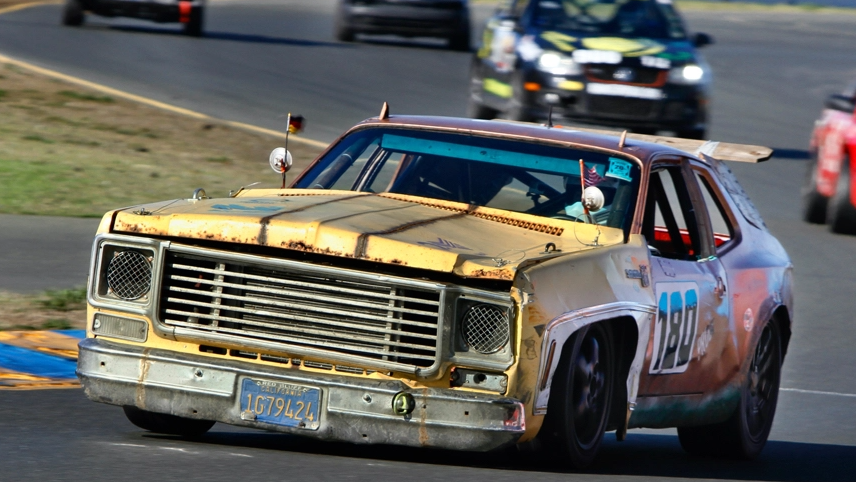Yes, This $500 Piece of Junk is a Real Racecar

Pictured above is a car that you almost certainly do not want to be driving in your day-to-day life. The front bumper is almost dragging on the ground. The hood is open and rusted. The front and back sections seem to be from different vehicles. The left blinker is busted. And you’ll certainly find more problems as you investigate further.
But amazingly, this car isn’t an everyday car — it’s more. It’s a racecar, and it has almost certainly competed in a race over the last few years. Maybe it even won.
If you’re familiar with auto endurance racing, you’ve heard of the 24 Hours of Le Mans, an annual road race that takes place in Le Mans, France, typically in June. (This year, the 100th anniversary of the first race, takes place from June 10th to 11th.) The goal of the race isn’t to finish the fastest, though — it’s to go the furthest, and to finish at all. The race lasts exactly 24 hours; the winning car is the one that travels the greatest distance over that time. The race takes place on a dedicated track that allows for speeds in excess of 200 miles per hour (350+ km/hr); the winning team in 2022 covered 3,217 miles (5,177 km) during the race.
The car above, though, obviously cannot do that. It’d be lucky if it could go 200 miles without falling apart (or falling further apart, I guess). But that’s okay, because it wasn’t an entrant in a 24 Hours of Le Mans race. It was an entrant in a 24 Hours of Lemons race, where drivers race clunkers in an epic battle of automobile survival.
In 2006, an automotive journalist named Jay Lamm came up with the idea for a race that anyone could enter, so long as you don’t take yourself too seriously, and the Lemon Race was born. The rules are simple: the main race, like Le Mans, is a 24-hour endurance race, but you can only spend $500 on your car. Expenses related to specific safety requirements — a roll cage, racing harnesses, fire suppression systems, etc. — are excluded from the $500 cap. You’re allowed to buy a more expensive car and sell off parts to meet get under the threshold, but if race judges deem your car is worth too much, they penalize you one race lap for every $10 over the limit.
The goal really isn’t to win — it’s to finish. As Yahoo! notes, “many of the teams don’t finish because of catastrophic mechanical failures,” so drivers and their teams need to embrace chaos if they’re entering into one of these contests. And if you do end up being the team with the most laps during the 24-hour period, you’re not winning a lot of money; in some cases, the prize money was paid out in nickels, and considering that $20 in nickels weighs more than four pounds, it’s unlikely your $500 car is going to be able to transport a big prize paid in nickels.
As absurd as the whole ordeal is, Lemon Races have proved rather popular — to a record-breaking degree. As Car and Driver reported, in 2014, “216 teams (sporting 1100+ drivers) took the starting laps at LeMons’ Thunderhill Raceway Park [in Northern California] event, which Guinness World Records certified as the “Most Participants in a Car Race.” And that only counts the teams whose cars were able to start the race — a total of 242 teams entered the race, but about 10% of the entrants turned into spectators when their cars wouldn’t start.
If this sounds like something you want to try, there’s some good news: there are lots of Lemon Races around the U.S. year-round. You can check out the race circuit’s official website, here, for a full calendar.
Bonus fact: Formula 1 race cars are very expensive, unlike Lemon Racing race cars. But on the other hand, Formula 1 race cars come with a very inexpensive safety feature, mandated by the rules — a wooden plank, as seen here. The plank, known as a “skid block,” ensures that drivers have enough clearance between their cars’ undercarriage and the ground. In general, there’s a strategic advantage to having the car be as close to the ground as possible — the physics make it easier to take tight turns at faster speeds. But if parts drag on the ground, the friction can damage the vehicle which renders it too dangerous to drive. The skid block, effectively, is a way to measure if the car is dragging against the ground; if the skid block shows wear and tear, that’s evidence that the car is violating the rules.
From the Archives: On the Juice: A story about lemons. Maybe.
